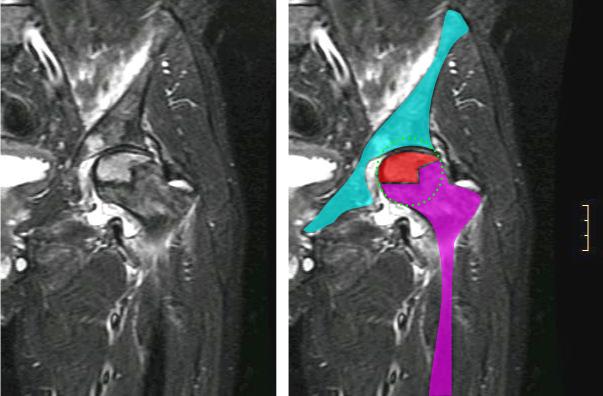In order to understand this condition it is important to understand the anatomy and function of the hip. Please read Hip Pain Info’s section on the anatomy of the hip.
The hip joint is a ball and socket joint. The ball is formed by the top of the thigh bone (the femur) and is called the “head” of the femur. The socket is formed by the bones of the pelvis and is called the acetabulum.
Articular cartilage is a smooth shiny material that covers the head of the femur and the acetabulum. Articular cartilage allows the head of the femur to move easily inside the acetabulum.

Jmarchn, CC BY-SA 3.0 https://creativecommons.org/licenses/by-sa/3.0, via Wikimedia Commons
What is osteonecerosis of the hip?
The term osteonecrosis is the term used to describe bone dying (“osteo” meaning bone and “necrosis” meaning dying). In osteonecrosis of the hip there is an interruption of the blood supply to the head of the femur. Without blood, the bone that forms the head of the femur and the articular cartilage that covers it can not get the nutrients that they need. The bone eventually dies. The head of the femur can lose its strength and collapse. The articular cartilage also breaks down.
What causes osteonecrosis of the hip?
What causes the blood supply to the head of the femur to be interrupted is not clear. It seems to occur more often in people aged 20 to 50 and in people with certain chronic (long term) medical conditions. Other risk factors for osteonecrosis of the hip include:
- Alcoholism
- Hip fracture or dislocation of the hip
- The use of corticosteroid medications
What is the treatment for osteonecrosis of the hip?
The treatment of osteonecrosis of the hip depends on its severity. Most types of treatment work best when osteonecrosis of the hip is detected early. Once it is detected, specialists that treat people with osteonecrosis of the hip can plan out a treatment program.
Hip Pain Info’s links section has additional information on osteonecrosis of the hip. Links have been provided to other websites as well as online medical journals. Visit Joint Pain Info for information on other joint injuries and problems.
